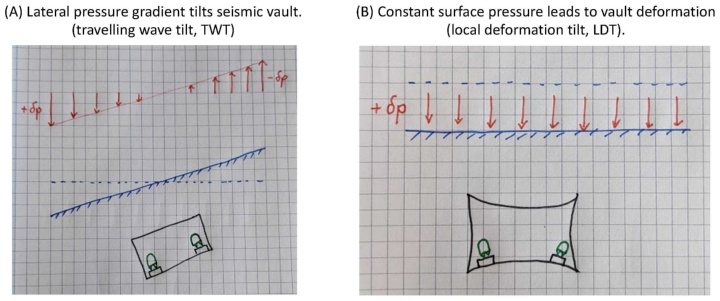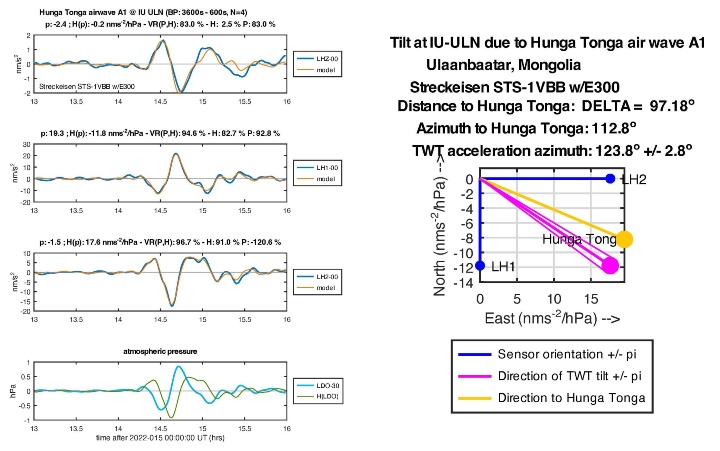This activity report summarizes a talk presented at the 25th InSight science team meeting in London in November 2022 and was co-authored by my colleagues at the Black Forest Observatory (BFO): Thomas Forbriger and Walter Zürn. The Hunga-Tonga volcano erupted in January 2022 and radiated energy in the atmosphere, the oceans and the solid Earth. A number of signals could be observed with unprecedented signal-to-noise ratio: seismic free oscillations of the solid Earth, meteo tsunamis in the oceans, globe circling Lamb waves in the atmosphere, to mention just a few. In this contribution, we focus on the Lamb waves recorded by barometers and broad-band seismometers of the Global Seismic Network (GSN). With a phase velocity of approx. 315 m/s the Lamb wave was the fastest pressure signal propagating in the atmosphere with a dominant signal period of around 45 minutes. Except near the source, peak-to-peak amplitudes for the direct wave was typically 2–3 hPa.

Based on previous work (Zürn et al., GJI, 2021) we expect that the response of horizontal component seismometers at these long periods is dominated by tilts due to two distinct physical mechanisms: (A) tilt due to the local deformation of the vault in which the accelerometer is installed: e.g. warping of the vault floor in response to an atmospheric pressure change. We refer to this as local deformation tilt, LDT. (B) a regional tilt due to a lateral pressure gradient along the surface above the seismic vault. We call this travelling wave tilt, TWT. This nomenclature derives from the fact that for an elastic medium the tilt of the vault follows the free surface, and together they tilt in the direction of the surface pressuregradient (Figure 1). While LDT is in phase with the locally recorded atmospheric pressure change, the TWT is 90 degrees out of phase. Thus, LDT is proportional to the pressure, p(t), while TWT is proportional to its Hilbert transform, H(p(t)). These two signals are linearly independent and in a regression where scaled versions of the two signals are sought to match the horizontal accelerograms one can separate the contributions of the two tilt mechanisms. The estimatedTWT scale factors for the two horizontal components can be vectorially added and the resulting vector should align with the back-azimuth to Hunga Tonga. (Figure 2).

We have inspected all the recordings by the Global Seismic Networks GSN and GEOSCOPE of the Hunga Tonga Lamb wave and only retained 21 stations with clean signals on all baro- and seismograms. 18 of these stations are also equipped with a secondary broad-band sensor for redundancy. Thanks to the secondary sensors, instrumental anomalies could be identified at 5 stations: ALE, TAU, FFC, KMBO, WCI. For any 3-component sensor, the tilt due to vault deformation (LDT) points in a fixed, sensor specific direction independent of the Lamb wave propagation direction. This is in agreement with the vault deformation model. We find that LDT is larger thanTWT at 80 % of retained GSN stations. While accelerations can be well modeled in most cases, pressure gradient induced ground tilts point towards Hunga Tonga for only seven stations: BFO, ESK, KAPI, WRAB, WVT, ULN, INCN.
Currently, we lack any model which would allow us to explain the majority of the observed TWT tilt directions of the Hunga-Tonga Lamb wave, as we do not think that Lamb wave front deformations due to wind or temperature variations in the atmosphere can account for the observed tilt misalignments.
For the analysis of observed atmospheric pressure drops and simultaneous seismometer tilts caused by the passage of dust devils near the lander of the NASA InSight mission to Mars, the above findings will lead to a critical reevaluation of our models to interpret the observed seismometer tilt directions: so far in all studies the possibility of local deformation tilt due to, for example, heterogeneities in the regolith underneath the seismometer feet has been completely ignored.

